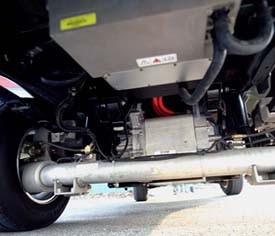 BATAVIA, Ill.–With more than 25 percent of the vehicles in its fleet now equipped to run on alternative fuels, the Department of Energy’s Fermilab is well along the road to reaching the federally mandated goal of a 20 percent reduction in fossil fuel use by FY 2005.
BATAVIA, Ill.–With more than 25 percent of the vehicles in its fleet now equipped to run on alternative fuels, the Department of Energy’s Fermilab is well along the road to reaching the federally mandated goal of a 20 percent reduction in fossil fuel use by FY 2005.
The lab now has 63 alternative-fuel vehicles: 20 vehicles running on E85, a mixture of gasoline and alcohol containing up to 85 percent ethanol; 40 vehicles capable of running on either compressed natural gas (CNG) or conventional gasoline; and three vehicles running exclusively on electricity. The lab has also reduced its total fleet by 18 vehicles in the last two years, and recently had a 6,000-gallon E85 underground storage tank and fuel delivery system installed thanks to the Department of Energy.
Says Jeff Irvin, assistant head of Fermilab’s Business Services Section: “We received supplemental funding right near the end of the last fiscal year, through DOE-HQ’s Office of Energy Efficiency and Renewable Energy, and administered by DOE-Idaho. We’re looking for a big impact in fossil fuel reduction this year.”
The effort at Fermilab, and across federal agencies, stems from Executive Order 13149, “Greening the Government Though Federal Fleet and Transportation Efficiency,” issued by President Clinton on April 21, 2000. The goal for “Reduced Petroleum Fuel Consumption” states: “Each agency operating 20 or more motor vehicles within the United States shall reduce its entire fleet’s annual petroleum consumption by at least 20 percent by the end of FY 2005, as compared with FY 1999 petroleum consumption levels.”
In FY ’99, Fermilab vehicles used 100,578 gallons of gasoline and 28,166 gallons of diesel fuel. To meet federal requirements, Fermilab’s targets for FY ’05 consumption are about 80,000 gallons of gasohol and about 22,500 gallons of diesel fuel. So far, the only differences noted by the lab’s transportation corps are the changes in hookups for the new fuels, and the recharging connections for the near-silent electric vehicles.
“Everything is basically operating the same as always, with no differences,” says Brian Niesman, manager for distribution and shipping in Business Services. “The vehicles can do everything they did previously, and that’s the whole point. We are still moving items from point A to point B, whether people, parts or equipment, and we’re burning much cleaner fuel while we do it.”
Vehicles are owned by the Department of Energy or leased through the General Services Administration, which negotiates with manufacturers. The DOE’s list of alternative fuels includes alcohols (ethanol E85 and methanol); compressed natural gas (CNG); electricity stored in batteries; hydrogen; liquefied petroleum gas (LPG); liquids from coal; and biodiesel, made from plant oils or animal fats. On the horizon for Fermilab and other federal facilities are gasoline-electric hybrid vehicles, and vehicles using hydrogen fuel cell technology.
“There hasn’t been a lot of fanfare surrounding this effort,” Irvin says, “but we view it as making significant progress in energy management and pollution control.”
Fermilab is a U.S. Department of Energy/Office of Science national laboratory, operated under contract by Universities Research Association, Inc.
CAPTION: Battery in the undercarriage of one of the lab’s three electrically powered pickup trucks. Photo by Fermilab Visual Media Services
